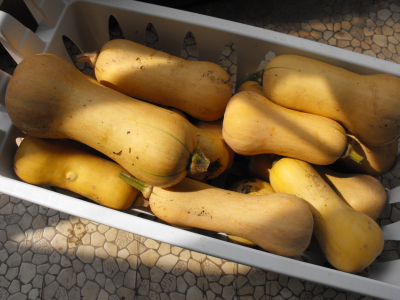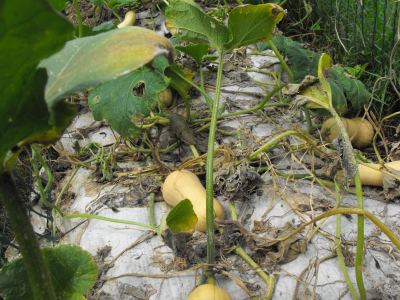
Butternut harvest
 "Look
at all the butternuts I harvested,
honey!" I said proudly. "And we've got four more left in the
garden."
"Look
at all the butternuts I harvested,
honey!" I said proudly. "And we've got four more left in the
garden."
Mark glanced over at my
22 pounds of butternuts and replied --- "Four
more baskets?" Shame-faced, I had to shake my head no. I
only had four more squash in the garden.
The truth is that when I
planned our three butternut beds this year, I
should have realized that Mark had turned a general preference for
these winter squash into an outright craving. Already, he's
talking about buying some butternuts from a friend, and he has the
right idea. Now's the perfect time of year to stock up on any
vegetables of which you have an unexpected shortfall (or ones that your
husband suddenly decides he adores and wants three times as
many of.)
 If
you planted your butternuts a bit late (which would have been
smart), they might not be ready to harvest yet. Wait until your
vines are dying back, your fruits are fully tan, and the stems have
begun to brown (but be absolutely certain to harvest before the first
frost.) Then carefully cut each butternut off the vine, leaving
an inch of stem on the fruit. Never toss the butternuts around
--- even though they look hardy, they actually bruise quite quickly if
treated harshly.
If
you planted your butternuts a bit late (which would have been
smart), they might not be ready to harvest yet. Wait until your
vines are dying back, your fruits are fully tan, and the stems have
begun to brown (but be absolutely certain to harvest before the first
frost.) Then carefully cut each butternut off the vine, leaving
an inch of stem on the fruit. Never toss the butternuts around
--- even though they look hardy, they actually bruise quite quickly if
treated harshly.
Some people wash their
butternuts gently in a solution of bleach water
after harvesting to kill off any fungi living on the skin, but I've had
good luck storing our butternuts as is. For best flavor, allow
the squash to cure at 80 to 85 degrees Fahrenheit for a couple of
weeks, then store in a cool (50 to 60 F), dry place. We keep our
butternuts in a kitchen cabinet and eat them until the middle of the
winter...or until we run out.
Want more in-depth information? Browse through our books.
Or explore more posts by date or by subject.
About us: Anna Hess and Mark Hamilton spent over a decade living self-sufficiently in the mountains of Virginia before moving north to start over from scratch in the foothills of Ohio. They've experimented with permaculture, no-till gardening, trailersteading, home-based microbusinesses and much more, writing about their adventures in both blogs and books.
Want to be notified when new comments are posted on this page? Click on the RSS button after you add a comment to subscribe to the comment feed, or simply check the box beside "email replies to me" while writing your comment.

Just let them sit somewhere exposed to air at warm temperatures for a week or two --- we have ours sitting in a basket on the kitchen floor. Technically, you're supposed to store the squash at a cooler temperature, and I think if you throw them right into a cool place, they don't develop a tough enough rind to make them last through the winter.
On the other hand, I've read on a couple of different extension service websites that some folks think curing isn't actually necessary for butternuts. (And it's supposed to be a bad idea for acorn squash, making them spoil quicker.) So I wouldn't worry too much about it! Just don't put them away damp.